
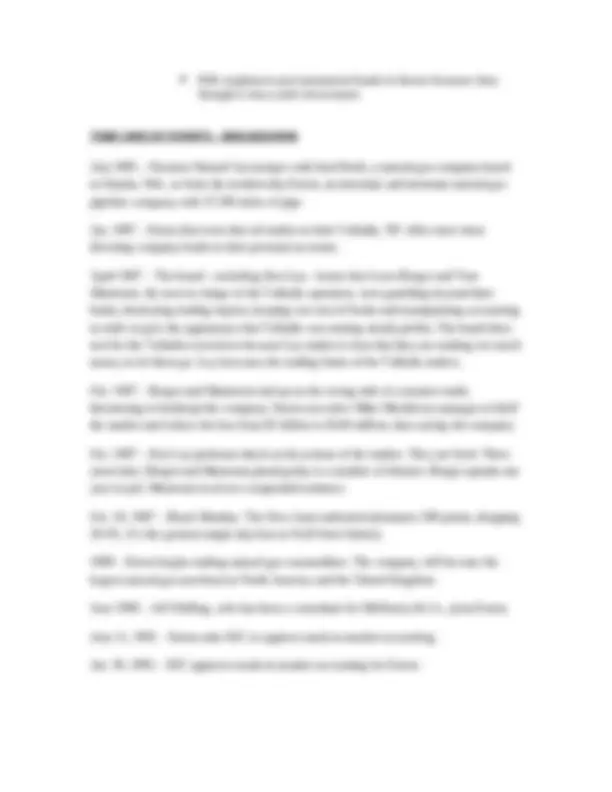
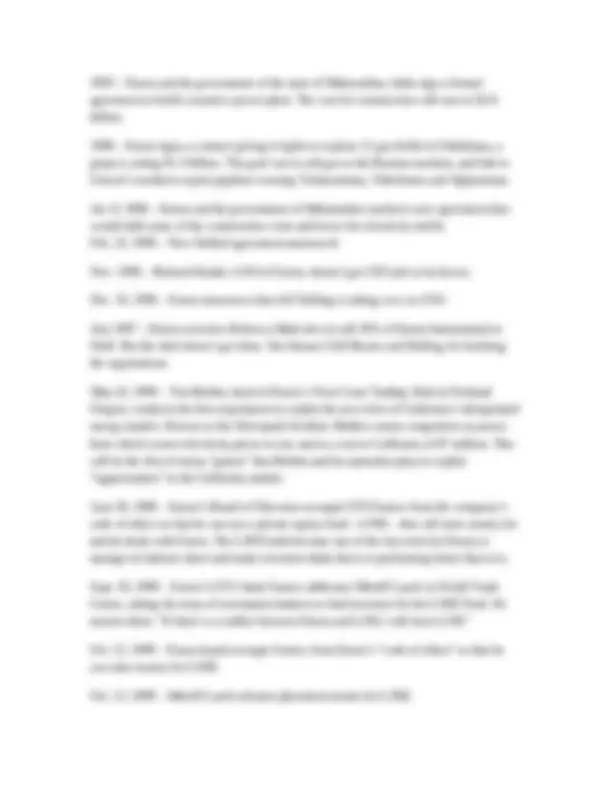
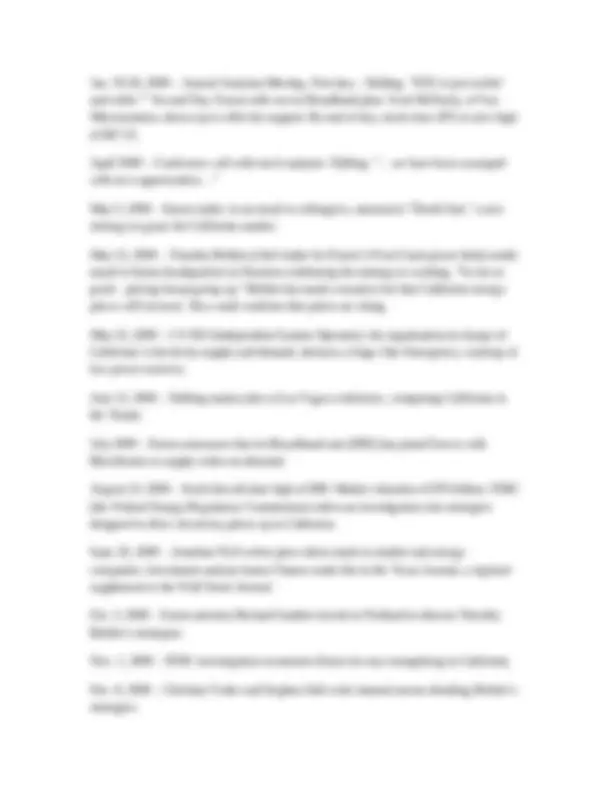
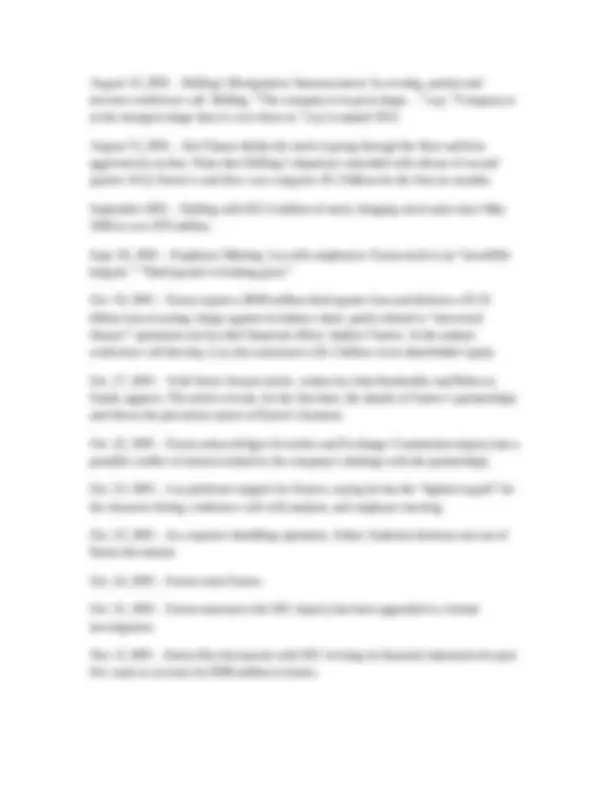
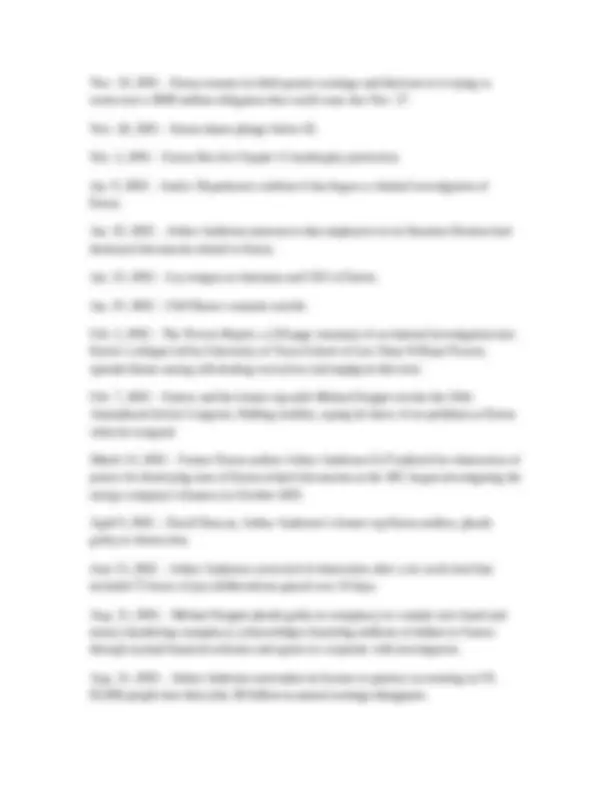
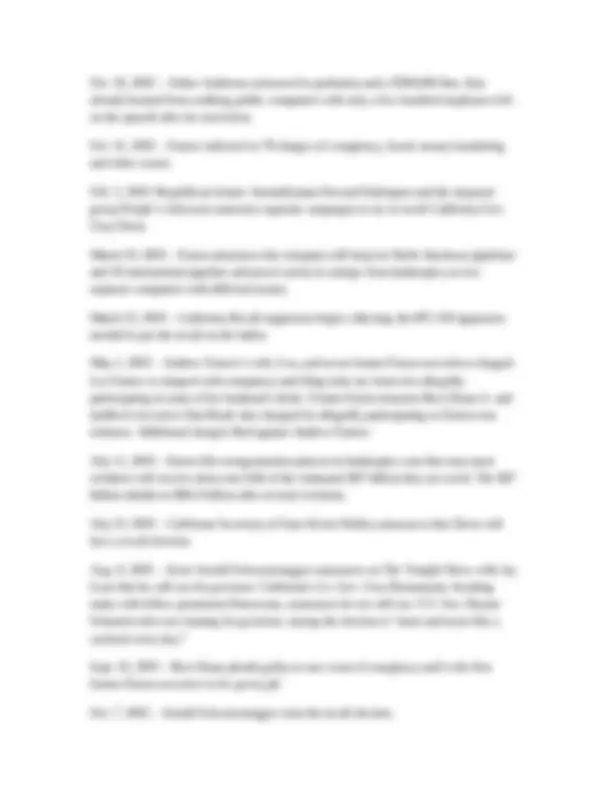


Study with the several resources on Docsity

Earn points by helping other students or get them with a premium plan


Prepare for your exams
Study with the several resources on Docsity

Earn points to download
Earn points by helping other students or get them with a premium plan
Community
Ask the community for help and clear up your study doubts
Discover the best universities in your country according to Docsity users
Free resources
Download our free guides on studying techniques, anxiety management strategies, and thesis advice from Docsity tutors
An in-depth look into the enron scandal, a case of corporate fraud and accounting irregularities that led to the downfall of one of the largest energy companies in the world. The company's growth, the role of key executives, the use of mark-to-market accounting, the prc process, and the various scandals that ultimately led to enron's bankruptcy. The document also includes a timeline of events.
Typology: Study notes
1 / 12

This page cannot be seen from the preview
Don't miss anything!







Jeff Skilling o Converted stock for 66 million dollars o The Guy with the big ideas. To find a new way to deliver energy Would become a stock market for natural gas. Became the largest buyer/seller in energy and natural gas o Amanda Martin- Executive Jeff hired o Skilling had one condition before he joined Enron That he would be allowed to use a certain accounting method known as mark to market. Arthur Anderson signed off on it and the FCC approved it. Mark to Market accounting allowed Enron to book potential future profits on the day a deal was signed, no matter how much cash actually came through the door. o Now Enron could set what ever profits they wanted to. o PRC Process Review process for employees Ranked 1-5 were 10% had to be a 5 o The 5’s were fired. o Equivalent to 15% of the company every year. o Enron’s traders became the biggest ever. Turned Jeff’s free market beliefs into success Many Enron employees got paid through their stock because of how high it was. o Analyst Bought stock in Enron Ate out of the companies hand Those Analyst were didn’t buy stock were considered enemies of Enron John Olsten was one of the only analysts who had any form of doubt about Enron. o Merril Liych Fired john Olson They received a large Money gift from Andrew Fastow in thanks for getting rid of a potential problem. Enron got into energy within Bandwidth (Internet) o Started to buy/sell/trade bandwidth energy. o Enron stock raised 34% in two days. o Going to make a deal to stream movies with Block Buster online Deal fell through.
BUT with Mark to Market accounted they recorded future assets to make it seem that Enron made 53 million dollars off the Block Buster deal even though the deal never happened. o Executives began to sell their own stocks This was the start of the fast downfall. Ken Lay – CEO- “Captain of the Ship” o PHD Economics o Deregulation - $ through it How to get government out of Energy Governor of Texas Strong relations to the Bush Family o Helped Enron with billions of dollars in subsidies. o Vahalla Scandal - Mis-appropriation on oil with traders Made false bank records Auditors told executives of mal-practice Traders weren’t disciplined o Memo: “keep making us millions” Ken Lay is a lire Behind Bars Lou Pie o Skillings – “My ICBM” o “The invisible CEO” o 2 things motivated Pie Money and Strippers Used Enron money on strippers. o Left Enron with 220 million dollars Sold all stock Became the 2nd^ largest land owner in CO Divorced wife and married a stripper with his child o Lost the company 1 billion dollars Which the company covered up. Merger with PGE (Portland General Electrics) o Put Enron to the energy business Put Enron on the map in CA o PGE stock became Enron
1993 – Enron and the government of the state of Maharashtra, India sign a formal agreement to build a massive power plant. The cost for construction will soar to $2. billion. 1996 – Enron signs a contract giving it rights to explore 11 gas fields in Uzbekistan, a project costing $1.3 billion. The goal was to sell gas to the Russian markets, and link to Unocal’s southern export pipeline crossing Turkmenistan, Uzbekistan and Afghanistan. Jan. 8, 1996 – Enron and the government of Maharashtra reached a new agreement that would shift some of the construction costs and lower the electricity tariffs. Feb. 23, 1996 – New Dabhol agreement announced. Nov. 1996 – Richard Kinder, COO of Enron, doesn’t get CEO job so he leaves. Dec. 10, 1996 – Enron announces that Jeff Skilling is taking over as COO. July 1997 – Enron executive Rebecca Mark tries to sell 50% of Enron International to Shell. But the deal doesn’t get done. She blames Cliff Baxter and Skilling for botching the negotiations. May 24, 1999 – Tim Belden, head of Enron’s West Coast Trading Desk in Portland Oregon, conducts his first experiment to exploit the new rules of California’s deregulated energy market. Known as the Silverpeak Incident, Belden creates congestion on power lines which causes electricity prices to rise and at a cost to California of $7 million. This will be the first of many “games” that Belden and his operation play to exploit “opportunities” in the California market. June 28, 1999 – Enron’s Board of Directors exempts CFO Fastow from the company’s code of ethics so that he can run a private equity fund—LJM1—that will raise money for and do deals with Enron. The LJM Funds become one of the key tools for Enron to manage its balance sheet and make investors think that it is performing better than it is. Sept. 16, 1999 – Enron’s CFO Andy Fastow addresses Merrill Lynch in World Trade Center, asking the team of investment bankers to find investors for his LJM2 Fund. He assures them: “If there’s a conflict between Enron and LJM, I will favor LJM.” Oct. 12, 1999 – Enron board exempts Fastow from Enron’s “code of ethics” so that he can raise money for LJM2. Oct. 13, 1999 – Merrill Lynch releases placement memo for LJM2.
Jan. 19-20, 2000 – Annual Analysts Meeting. First day – Skilling: “EES is just rockin’ and rollin.’” Second Day: Enron rolls out its Broadband plan. Scott McNealy, of Sun Microsystems, shows up to offer his support. By end of day, stock rises 26% to new high of $67.25. April 2000 – Conference call with stock analysts. Skilling: “…we have been swamped with new opportunities…” May 5, 2000 – Enron trader, in an email to colleagues, announces “Death Star,” a new strategy to game the California market. May 12, 2000 – Timothy Belden (chief trader for Enron’s West Coast power desk) sends email to Enron headquarters in Houston confirming his strategy is working. “So far so good…pricing keeps going up.” Belden has made a massive bet that California energy prices will increase. His e-mail confirms that prices are rising. May 22, 2000 – CA ISO (Independent System Operator), the organization in charge of California’s electricity supply and demand, declares a Stage One Emergency, warning of low power reserves. June 12, 2000 – Skilling makes joke at Las Vegas conference, comparing California to the Titanic. July 2000 – Enron announces that its Broadband unit (EBS) has joined forces with Blockbuster to supply video-on-demand. August 23, 2000 – Stock hits all-time high of $90. Market valuation of $70 billion. FERC (the Federal Energy Regulatory Commission) orders an investigation into strategies designed to drive electricity prices up in California. Sept. 20, 2000 – Jonathan Weil writes piece about mark-to-market and energy companies. Investment analyst James Chanos reads this in the Texas Journal, a regional supplement to the Wall Street Journal. Oct. 3, 2000 – Enron attorney Richard Sanders travels to Portland to discuss Timothy Belden’s strategies. Nov. 1, 2000 – FERC investigation exonerates Enron for any wrongdoing in California. Dec. 6, 2000 – Christian Yoder and Stephen Hall write internal memo detailing Belden’s strategies.
March, 2001 – Enron transfers large portions of EES business into wholesale to hide EES losses. March, 2001 – Arthur Andersen takes auditor Carl Bass off the Enron account. March 23, 2001 – Enron schedules unusual analyst conference call to boost stock. It works. April 17, 2001 – Quarterly Conference Call. The “asshole” call. May 17, 2001 – “Secret” meeting at Peninsula Hotel in LA—Schwarzenegger, Lay, Milken. June 21, 2001 – Skilling hit in face with blueberry tofu cream pie by Francine Cavanaugh at The Commonwealth Club in San Francisco. June 2001 – FERC finally institutes price caps across the western states. The California energy crisis ends. July 12, 2001 – Quarterly Conference Call. Skilling still bullish. July 13, 2001 – Skilling announces desire to resign to Lay. Lay asks Skilling to take the weekend and think it over. There are two different views of what happened that day. According to Lay, he tried to talk Skilling out of resigning. Skilling says Lay didn’t seem to care and that he offered to stay on for six months. Board member says he recommended the transition period to Lay. Lay claims Skilling wanted an immediate out. July 24-25, 2001 – Skilling meets with analysts and investors in NY. “We will hit those numbers. We will beat those numbers.” Says LJM is stopping and that all other issues are immaterial. “All of these are bunk. These are not issues for the stock.” August 3, 2001 – Skilling makes a bullish speech on EES. That afternoon, he lays off 300 employees. August 11, 2001 – Skilling talks to Mark Palmer about preparing press release for resignation. August 13, 2001 – Board Meeting. Rick Buy outlines disaster scenario if Enron’s stock starts to fall. All SPEs crash. Skilling dismisses this. That evening, in board only session, Skilling, in tears, resigns.
August 14, 2001 – Skilling’s Resignation Announcement. In evening, analyst and investor conference call. Skilling: “The company is in great shape…” Lay: “Company is in the strongest shape that it’s ever been in.” Lay is named CEO. August 15, 2001 – Jim Chanos thinks the stock is going through the floor and bets aggressively on that. Notes that Skilling’s departure coincided with release of second quarter 10-Q. Enron’s cash flow was a negative $1.3 billion for the first six months. September 2001 – Skilling sells $15.5 million of stock, bringing stock sales since May 2000 to over $70 million. Sept. 26, 2001 – Employee Meeting. Lay tells employees: Enron stock is an “incredible bargain.” “Third quarter is looking great.” Oct. 16, 2001 – Enron reports a $638 million third quarter loss and declares a $1. billion non-recurring charge against its balance sheet, partly related to “structured finance” operations run by chief financial officer Andrew Fastow. In the analyst conference call that day, Lay also announces a $1.2 billion cut in shareholder equity. Oct. 17, 2001 – Wall Street Journal article, written by John Emshwiller and Rebecca Smith, appears. The article reveals, for the first time, the details of Fastow’s partnerships and shows the precarious nature of Enron’s business. Oct. 22, 2001 – Enron acknowledges Securities and Exchange Commission inquiry into a possible conflict of interest related to the company’s dealings with the partnerships. Oct. 23, 2001 – Lay professes support for Fastow, saying he has the “highest regard” for his character during conference call with analysts, and employee meeting. Oct. 23, 2001 – In a massive shredding operation, Arthur Andersen destroys one ton of Enron documents. Oct. 24, 2001 – Enron ousts Fastow. Oct. 31, 2001 – Enron announces the SEC inquiry has been upgraded to a formal investigation. Nov. 8, 2001 – Enron files documents with SEC revising its financial statements for past five years to account for $586 million in losses.
Oct. 16, 2002 – Arthur Andersen sentenced to probation and a $500,000 fine; firm already banned from auditing public companies with only a few hundred employees left on the payroll after its conviction. Oct. 31, 2002 – Fastow indicted on 78 charges of conspiracy, fraud, money laundering and other counts. Feb. 5, 2003: Republican former Assemblyman Howard Kaloogian and the taxpayer group People’s Advocate announce separate campaigns to try to recall California Gov. Gray Davis. March 19, 2003 – Enron announces the company will keep its North American pipelines and 18 international pipeline and power assets to emerge from bankruptcy as two separate companies with different names. March 25, 2003 – California Recall supporters begin collecting the 897,158 signatures needed to put the recall on the ballot. May 1, 2003 – Andrew Fastow’s wife, Lea, and seven former Enron executives charged. Lea Fastow is charged with conspiracy and filing false tax forms for allegedly participating in some of her husband’s deals. Former Enron treasurer Ben Glisan Jr. and midlevel executive Dan Boyle also charged for allegedly participating in Fastow-run schemes. Additional charges filed against Andrew Fastow. July 11, 2003 – Enron files reorganization plan in its bankruptcy case that says most creditors will receive about one fifth of the estimated $67 billion they are owed. The $ billion shrinks to $66.4 billion after several revisions. July 23, 2003 – California Secretary of State Kevin Shelley announces that Davis will face a recall election. Aug. 6, 2003 – Actor Arnold Schwarzenegger announces on The Tonight Show with Jay Leno that he will run for governor. California’s Lt. Gov. Cruz Bustamante, breaking ranks with fellow prominent Democrats, announces he too will run. U.S. Sen. Dianne Feinstein rules out running for governor, saying the election is “more and more like a carnival every day.” Sept. 10, 2003 – Ben Glisan pleads guilty to one count of conspiracy and is the first former Enron executive to be put in jail. Oct. 7, 2003 – Arnold Schwarzenegger wins the recall election.
Nov. 18, 2003 – Enron announces it will sell Portland General Electric, its Pacific Northwest utility, to partnership backed by Texas Pacific Group for $1.25 billion in cash and $1.1 billion in assumed debt. Jan. 6, 2004 – Enron Corp.’s roadmap for emerging from bankruptcy receives a New York judge’s initial blessing and will be sent to creditors to accept or reject the plan that will pay them a fraction of what they are owed. Jan. 14, 2004 – Andrew and Lea Fastow plead guilty.